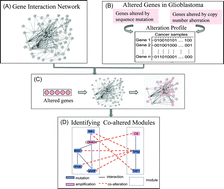The heterogeneity of genetic alterations in human cancer genomes presents a major challenge to advancing our understanding of cancer mechanisms and identifying cancer driver genes. To tackle this heterogeneity problem, many approaches have been proposed to investigate genetic alterations and predict driver genes at the individual pathway level. However, most of these approaches ignore the correlation of alteration events between pathways and miss many genes with rare alterations collectively contributing to carcinogenesis. Here, we devise a network-based approach to capture the cooperative functional modules hidden in genome-wide somatic mutation and copy number alteration profiles of glioblastoma (GBM) from The Cancer Genome Atlas (TCGA), where a module is a set of altered genes with dense interactions in the protein interaction network. We identify 7 pairs of significantly co-altered modules that involve the main pathways known to be altered in GBM (TP53, RB and RTK signaling pathways) and highlight the striking co-occurring alterations among these GBM pathways. By taking into account the non-random correlation of gene alterations, the property of co-alteration could distinguish oncogenic modules that contain driver genes involved in the progression of GBM. The collaboration among cancer pathways suggests that the redundant models and aggravating models could shed new light on the potential mechanisms during carcinogenesis and provide new indications for the design of cancer therapeutic strategies.

You have access to this article
 Please wait while we load your content...
Something went wrong. Try again?
Please wait while we load your content...
Something went wrong. Try again?


 Please wait while we load your content...
Please wait while we load your content...